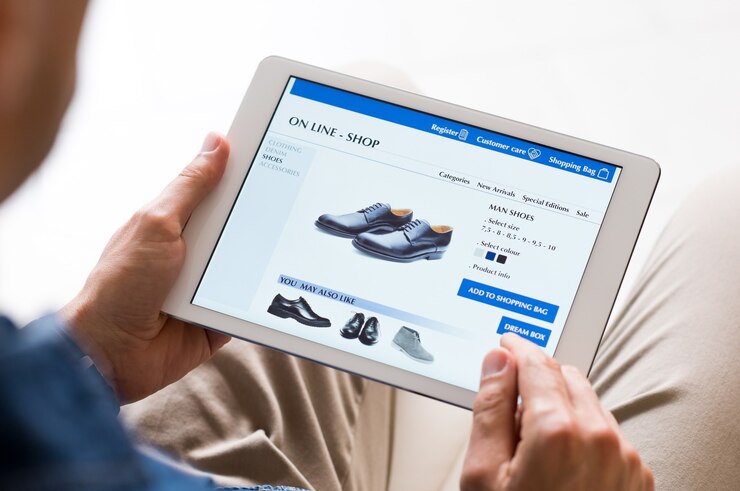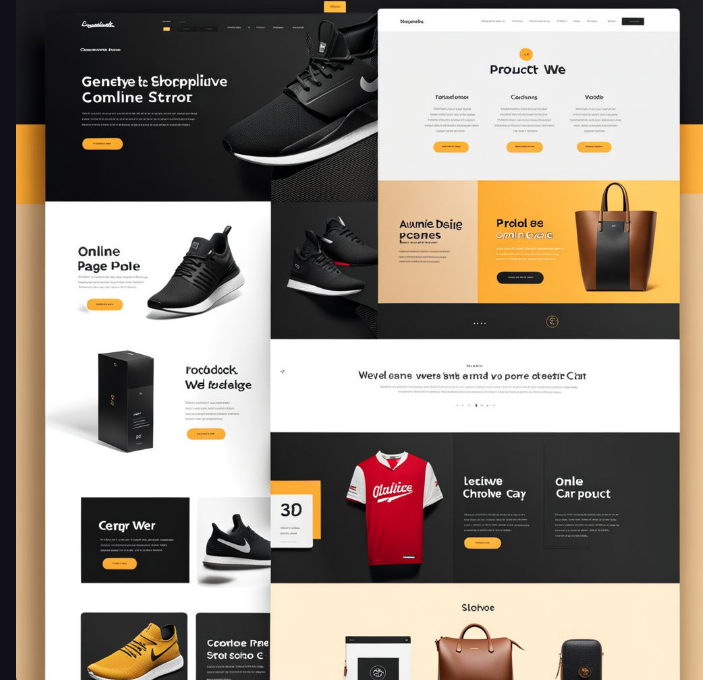7 methods for organizing products in an online store
-
Leonid Vlasov
Copywriter Elbuz
Proper organization of goods in an online store is like a brilliant puzzle, where every detail has its own special place. What if I told you about 7 unique ways to organize products that will make the shopping experience in your store even more convenient and attractive? Get ready to explore new horizons in running your online business as I am ready to share with you the most effective and proven methods that will help improve your customer satisfaction. So, let's figure out this complex puzzle together and make life easier for customers!

Glossary
- Product specifications: This is information about the properties and features of a product that helps customers make an informed purchasing decision.
- Varieties of characteristics: include the main characteristics of the product (for example, size, color) and additional characteristics (for example, material, brand).
- Product Options: Additional Features: These are additional features that a product may have that need to be specified for better understanding by the buyer.
- What is important to consider when specifying the characteristics: recommendations for correctly filling out product characteristics, such as using exact values, avoiding general terms, etc.
- Subdividing products into types and categories: This is the process of grouping products into common characteristics or categories to make navigation and search easier for buyers.
- Product Item Types: Various classifications of products based on their attributes, such as clothing, shoes, accessories.
- Product item categories: this is a narrower grouping of products within each type, for example, men's clothing, women's clothing, children's clothing.
- Category tree formation: the process of organizing product categories into a hierarchical structure, which is a tree where each category has a parent and a child category.
- Product Category Naming: Choose unique and descriptive names for each product category to create a clear, easy-to-navigate structure.
- Creating and setting up product categories in an online store on the ELBUZ platform: the process of adding and setting up product categories using the built-in tools and functions provided by the ELBUZ platform.
- Brief summary: a brief summary and overview of the main ideas of the article about the systematization of goods in an online store and its advantages for the convenience of customers.
Structuring products in an online store: creating categories for the convenience of customers
When I first I started running my own online store, I ran into the problem of organizing products in the catalog. Without a clear systematization, customers had difficulty finding the right product, which negatively impacted the user experience and conversion of my store. So I decided to create a clear and logical category structure that made the purchasing process more convenient for my customers.

Product characteristics are one of the key elements that need to be specified, even if your assortment consists of only a few products. They allow potential customers to easily navigate product cards and select products that meet their requirements.
Imagine that you are looking for shoes in an online store, and you want to find shoes of a certain material, a certain size, a certain color, and made by a certain manufacturer. Without specifying these characteristics, you will waste time viewing product pages that do not interest you. And if there are characteristics on the product page, you can immediately select the product you need.
Effectively listing product features also helps with search engine optimization and improves your store's visibility in search engines. Shoppers often search for products based on specific characteristics, so specifying product parameters allows your store to appear on the search results page.
An example of how I systematized products in my online store is the shoe category. For each subcategory, I indicated the characteristics that influence the buyer's choice. For example, for low-top sneakers, I specified the material, size, color and brand. Thus, the buyer can easily filter the sneakers according to his preferences and find exactly what he needs.
In practice, I have found that properly specifying features and creating a logical category structure has helped improve the customer experience and increase the conversion rate of my online store. Customers were able to quickly find the product they needed, and I received unique data about the preferences and requirements of my audience.
In conclusion, I recommend that you always include product specifications in your online store. This will help create a convenient customer experience, improve sales performance, and enrich your audience with useful information.

💡 Tip: Make sure that you correctly structure the product categories in your online store and indicate all the necessary product characteristics. This will help simplify the purchasing process for your customers and increase store conversion.
What to do:
- Create a logical structure of product categories in your online store
- Include all important product features
- Allow users to filter products by features
- Use features for search engine optimization
What not to do:
- Not describing product characteristics in enough detail
- Creating too many categories, which makes it difficult for the user to navigate
- Ignore customer requests related to certain product characteristics
Various types of product parameters in an online store : my recommendations
There are many product features in online stores that help customers choose the right product and improve the user experience. In this section, I will talk about the different types of parameters that you should consider when organizing products in your online store and give recommendations on how to use them.
1. Basic parameters
Basic parameters of products play an important role for customers choosing products in an online store. These characteristics are displayed in the product card and are the basis for filters that allow users to select products according to specified criteria. For example, if your online store specializes in selling bedding sets, the main parameters may include characteristics such as material, size, color and design.
To make it easier to find the right product on your website, I recommend specifying as many basic parameters as possible in product cards. This will help customers use various filters and queries to quickly and easily find the products they need.
2. Logistics parameters
Logistics parameters reflect the dimensional data of the product packaging, such as weight, height, depth and width. Unlike basic parameters, logistics characteristics are not displayed on the product page and do not require special attention from buyers. However, this is important information for your online store, since these parameters can affect shipping costs and how the product is packaged.
When filling out information about products in your online store, try to specify logistics parameters to ensure correct delivery cost calculations and provide customers with complete information before purchasing.

3. Additional parameters
Additional product parameters are characteristics that may be useful to customers during the product selection process. Such parameters may include information about the composition of the product, care instructions, or additional functionality. For example, if your online store specializes in selling cosmetics, additional parameters may include directions for use, expiration date, and care features for the product.
I recommend including additional options on the product page to provide buyers with all the information they need and help them make an informed choice.
Overview: Best Practices
The table below gives an overview of recommendations for organizing products:
| Parameter type | Recommendations |
|---|---|
| Basic parameters | Specify as many basic characteristics as possible |
| Logistic parameters | Specify the dimensional details of the product packaging |
| Additional parameters | Provide additional useful information |
It is important to note that these recommendations are based on my experience and practice in online stores. By following these recommendations, you can improve the systematization of products in your online store, increase the convenience of customers and, as a result, increase conversion.

Specification Guidelines
When you open the page of an online store, you expect to receive maximum useful information about the product in order to make the right decision about its purchase. However, many stores do not pay enough attention to the quality presentation of products on their pages. In this section, I want to tell you about the importance of indicating the characteristics of a product on its page and offer some recommendations for indicating them correctly.
When you list a product in your online store, one of the key tasks is to create a high-quality product card. It is important to indicate at least three main parameters for each product item, ideally five or more. Why is it important? Because it will be much easier and faster for the client to make a choice if he can get enough information about the product.

It is necessary to ensure that all information presented in the characteristics of the product fully corresponds to its description, name and photographs. Deviations can cause mistrust among customers and affect the quality of the user experience.
Be sure to write down the basic parameters that are required to select a product - size, color, material, country of origin and others. This information will help customers make purchasing decisions based on important criteria.
In addition to the basic parameters, try to supplement the product card with additional parameters, for example, care recommendations or methods of application. Such additional characteristics will enrich the product description and help customers better understand its features and benefits.
To make it convenient for customers to filter products on your marketplace, think in advance about what specific characteristics the filtering will be based on. After this, start creating individual product parameters. Each catalog section must have its own set of parameters that are taken into account when filtering products.
Remember that product specifications should be concise and reflect the specific properties of the product. Do not add extra text from the product description to the characteristics. A large amount of text will only distract users from studying the criteria they need.
In order to improve the user experience and increase the convenience of shopping, it is recommended to correctly indicate the characteristics of the product. Use a unified approach to presenting them on the page for all product categories. This will help avoid mixing and confusion with options in different sections of your online store.

Finally, be careful when listing product specifications on the pages of your online store. This will help customers get a better user experience and make choices faster. Correctly specified characteristics help to provide customers with maximum useful information about the product and make the purchase informed and satisfactory.
If you want to know more recommendations for organizing goods in an online store, please contact us. I have extensive experience in this field and am always ready to share my knowledge and advice.
"Indicating product characteristics in the description is an effective way to attract customers and increase sales. Competently compiling characteristics will help customers better understand the product and make an informed choice." - Yulia Shapovalova, expert at Hotline.
Overview
| Specify all the main parameters of the product | + |
|---|---|
| We supplement the product card with additional characteristics | + |
| Maintain the correspondence between the characteristics and the description of the product | + |
| Taking a unified approach to characteristics in different categories | + |
| Avoid adding unnecessary text to the characteristics | + |
All these practices will help provide customers with the most useful information about the product and increase the convenience of shopping on your online store.

Item types
Large quantity Various individual characteristics of product items significantly complicate the work of an online store. To remedy the situation, the owners of trading platforms divide the assortment into types and categories.
Product type means a grouping of online store product items in accordance with individual characteristics and properties. Each entrepreneur who owns an electronic trading platform can create as many types of products as he needs for optimal organization of sales.
The combination of positions by type directly depends on the specifics of conducting commercial activities, the niche being developed in the field of eCommerce, the accounting system and the procedure for interaction with suppliers. Essentially, each seller determines independently how many product types he needs to create to work correctly.
When typing products, you can adjust the visibility of the product on the web page, display specific product items, and disable display of individual items or categories. This allows you to control the availability of goods and limit it only to certain users or groups of employees.
Depending on the specific business and product range, you can use various criteria to divide product items into types. For example, this may be the main functional type of the product, its target audience, seasonality and other characteristics.
For online store owners, product typing is a necessary tool for effectively organizing sales and improving customer convenience. As a sincere practitioner, I can confidently say that well-organized SKU types will help customers find their desired products faster and make purchases without wasting time and effort.

I recommend paying attention to the following aspects when working with product item types:
Identify the key characteristics of the product. Before creating product types, it is important to determine which characteristics and parameters are most important and informative to buyers. This may be the size, color, material and other features of the product.
Create a plan for product types. Write a detailed plan divided into types based on grouping products based on similar characteristics or customer needs. Don't forget to consider the specifics of your business and niche.
Combine products into groups. Create product groups within each type so that customers can easily find the product they need in the catalog. For example, within the "Clothing" type you can create groups "Men's clothing", "Women's clothing", "Children's clothing", etc.
Add additional product attributes. Expand your product filtering and sorting capabilities by adding additional attributes such as brand, price, availability, etc. This will allow customers to refine their preferences and quickly find the products they need.
Continuously analyze and optimize product line item types. Monitor changes in customer trends and needs to adapt product types in time and improve the user experience. Constantly improve your product systematization process and test new approaches.
Pay attention to SEO optimization of product item types. Optimize meta tags, titles, and descriptions for each product type to improve your store's visibility in search engines and attract more targeted visitors.
Use analytics to measure the performance of item types. Regularly track sales performance and buyer behavior across different product types. This will help you identify the most popular categories and tailor your sales strategy.
An online store with well-organized types of product items will make it easier for customers to search and select, save their time and increase the likelihood of a successful purchase. In my experience working with online stores, proper systematization of products helps not only improve the user experience, but also increase conversion and revenue.
.jpg)
Well-designed SKU types can help your online store become more convenient for shoppers, increase conversions, and increase profits. Remember to update and optimize your product categorization based on trends and the needs of your audience.
The convenience of customers and the success of an online store depend on the correct typing of goods.
In the table below I provide a high-level overview of useful and necessary steps when creating item types:
| What's good to do | What to avoid |
|---|---|
| Analyze customer needs | Create too many types |
| Identify key product characteristics | Do not update product item types |
| Create product groups within each type | Ignore trends and changes in customer needs |
| Add additional attributes to improve filtering | Ignore SEO optimization of product types |
| Constantly analyze the effectiveness of product types | Don't use analytics to evaluate results |

Correct product typing is a key tool for organizing products in an online store. Based on my experience working with various platforms, I can recommend using this strategy to optimally organize sales and increase customer convenience. Use your experience and knowledge to create product types that suit your business and the needs of your audience.
Naming product categories
How to choose product category names so that they are simple and understandable for customers?
Before you start creating a category tree in your online store, you should pay special attention to the names of each category. After all, they are the ones who will help users quickly navigate your catalog and find the products they need.
When thinking about titles for each section, try to avoid technical terms or slang. The main principle here is simplicity and clarity. Names should be as easy as possible for customers to perceive and understand.

When choosing a name for a specific product, it is recommended to use those options that are used most often. This way, you can be more specific to your customers' needs and use the terms they most often use when searching for products.
A good approach would be to base your search volume on the niche and the needs of potential buyers. Research and analyze what queries people use when choosing products, and you can more accurately select names for your sections.
It is also worth paying attention to the main sections so that they immediately convey to the user information about the availability of the necessary goods. Your goal is for the buyer, using the search, to immediately understand that it is in your online store that they can find the products they are looking for.
Thus, assigning names to product categories is an important step in forming the category tree of an online store. Give it the attention and responsibility you need to help your customers find the products they need quickly and easily.
Example:
Category: "Clothing"
Instead of using overly specialized terms that can confuse buyers, it is recommended to choose a simpler and clearer name such as "Clothing for Women". This will allow users to more easily navigate the product catalog and immediately understand exactly where they can find the things they need.
Overview table:
| What to do | What not to do |
|---|---|
| Use simple and clear category names | Use highly specialized terms |
| Consider customer demand and search frequency | Use slang expressions |
| Focus on customer needs and preferences | Ignore customer needs and preferences |
| Make titles informative about the contents of the section | Give titles that do not convey information about the contents |

In this section, we discussed the importance of naming the correct product categories in your online store. By choosing simple and understandable names, taking into account customer needs and using the frequency of search queries, you will help your customers quickly and easily navigate your catalog and find the products they need. This will improve the user experience and increase conversions in your online store.
Creating and setting up product categories in an online store
Owners of online stores are well aware that the systematization of goods plays an important role an important role in customer convenience and increased conversion. In this section, I will share with you my experience and practical tips on creating and setting up product categories in your online store.
To begin with, I’ll focus on the directory structure. A properly structured structure allows customers to quickly find the products they need and navigate through your assortment. When creating new categories and subcategories, it is important to think through the logic and hierarchy of sections.

The first step is to select the “Products” section in your control panel and click on the “On site” item. Then hover over the “Catalog” section and select “Create Category” through the settings gear. Provide a title for the new section, for example, "Kitchen knives", and create subcategories if necessary.
After creating sections, you will see a full structure consisting of sections and subsections. Now let's move on to setting up the generated categories. Point the cursor arrow to the name of the section and click on the gear, then select “Customize category”. The section card allows you to make changes to the category name, URL, location, and visibility.
So, the main work is done, but it is worth noting that creating and customizing categories is an ongoing process. Your online store may change and evolve, so regularly review your structure and analyze data on purchases and user interaction with categories.
Concluding this section, I want to emphasize the importance of systematizing products in an online store. A properly organized category structure helps customers quickly find the products they need and makes the purchasing process more comfortable. Remember to periodically analyze and optimize your category structure to improve user experience and increase conversions.
Advantages of properly organized product categories:
- Convenience for customers: Clearly structured categories help users quickly and easily find the product they need.
- Improved navigation: A well-designed catalog structure makes it easier for customers to navigate and navigate your online store.
- Increased conversion: the simplicity and convenience of searching for products leads to an increase in the number of completed purchases.
- SEO improvement: proper product systematization helps search engines better index the pages of your online store.
- Increases trust: Organizing products in a clear and structured way makes your store seem organized and professional.
Don't forget that your online store is your business card, so organize your products so that customers can easily navigate and find the products they need. Optimizing your category structure and constant attention to the customer experience will help increase conversions and increase the success of your online business.
What methods and systematization strategies did you use in your online store? Share your experiences and best tips in the comments below!
Best practices when organizing products in an online store:
| What to do | What not to do |
|---|---|
| ✔ Check the logic and structure of the directory | ✖ Don't create too many categories |
| ✔ Optimize category and subcategory names | ✖Don't change your catalog structure too often |
| ✔ Follow analytics and customer reviews | ✖ Don't ignore customer feedback |
| ✔ Optimize category and subcategory URLs | ✖ Don't use long and confusing URLs |
| ✔ Regularly update and optimize your structure | ✖ Don't fill categories without quality images |

To summarize: proper creation and configuration of product categories in an online store helps improve user experience and increase conversion. Don't forget to optimize your structure and regularly analyze your data for better results. Make shopping in your online store simple and convenient for every customer!
7 ways to organize goods in an online store: maximum comfort for customers
If you are an entrepreneur exploring the field of eCommerce , then you are probably familiar with the endless competition for every client. After all, in order for sales to grow steadily and your business to develop successfully, you need to provide maximum comfort and convenience for customers on your online store.
I strongly recommend that you set up your online storefront in such a way that the customer can easily find the products they need without experiencing much difficulty. After all, when a user feels comfortable searching and choosing products, he is inclined to purchase from you, as well as recommend your site to his friends and acquaintances.
Before you begin to create product categories, types, and options, it is important to carefully consider how to best organize your catalog. Each niche and business project in an online store has its own management features, which means they require a special approach to systematizing goods.

In order to make it as easy as possible for your customers to select and search for products, I will advise you to use the following effective systematization methods:
1. Classification by product type
Classifying products by type is one of the most common ways to make it easier for customers to navigate your online store. Depending on the specifics of your business, you can divide products into categories such as clothing, shoes, electronics, cosmetics and others.
2. Sorting by brand or manufacturer
If your online store has a wide range of products from different brands or manufacturers, you should definitely provide the ability to sort and filter products by brands or manufacturers. This will allow customers to quickly find the products they need and compare their characteristics.
3. Filtering by price range and characteristics
Buyers often need to filter an online store by price range and product characteristics. Providing filtering capabilities greatly simplifies selection and allows customers to find the right products as per their budget and requirements.
4. Customer reviews and product ratings
Including customer reviews and product ratings is an important element of systematizing products in an online store. This allows buyers to get additional information about the product from other users, as well as compare and choose the best option.
5. Recommendations of similar products or additional accessories
To increase customer convenience and stimulate additional sales, it is recommended to offer customers similar products or additional accessories that can be combined or complemented selected product. This allows customers to get a full set of necessary functionality and increase the average check.
6. Detailed descriptions with photographs and videos
The need for visual information about products for buyers is very great. Providing detailed descriptions, as well as photographs and videos of the product, allows customers to get a complete picture of the product, see it from all angles and make an informed purchasing decision.
7. Easy navigation and easy search
One of the key factors in creating a comfortable experience for customers is easy navigation and easy search on your online store. Providing intuitive sections, well-labeled categories and easy search will allow users to easily find the products they need and not get lost in the vastness of your store.
As a result of using these methods of systematizing goods in an online store, you will provide maximum comfort for your customers and increase the chances of successful completion of the transaction. I'm pleased to share these tips because they are based on my eCommerce experience and the success I've achieved in my own projects.

Don't forget that product systematization is an important stage in the development of your online store, which contributes to reliable customer retention and increased conversion. Use these effective methods and achieve success in your business!
"Success is not an accident. It is based on careful systematization." - Jeff Bezos.
Be sure to study and try to apply these methods in your business. In the table below, I will provide a general overview of the methods that are best practices in organizing products in an online store.
| Systematization method | What's useful | What do not use |
|---|---|---|
| Classification by type | Convenient division of goods by categories | Overloaded and unclear category names |
| Sort by brand | Quick search for products of a specific brand | Inability to select multiple brands |
| Product filtering | Quick search by price and characteristics | Limiting filters of categories and parameters |
| Reviews and ratings | Additional information about products | Removing or faking reviews |
| Product recommendations | Increase in average check | Intrusive and inappropriate offer |
| Visual information | Better presentation of the product | Poor quality of photos and videos |
| Easy navigation | Easy to find and navigate | Complex and confusing store structure |
Be We are confident that each of these methods will bear fruit and will help you create the most convenient and attractive platform for your customers. Good luck in your business!

Frequently asked questions on the topic "7 methods for organizing products in an online store "
1. Why is it important to systematize products in an online store?
Organizing products in an online store helps customers find the product they need more easily, improves their shopping experience, and increases the efficiency of the online store.
2. What characteristics of goods should be indicated?
You should indicate characteristics that are as informative as possible for buyers and help them make a purchasing decision.
3. How to correctly divide products into types and categories?
To correctly divide products into types and categories, it is necessary to analyze their similarities and differences, taking into account the needs and preferences of customers.
4. What types of product items can be applied?
SKU types can include products by category, brand, functionality, price range, and other characteristics.
5. What recommendations can you offer for indicating product characteristics?
It is recommended to indicate only the most important and significant characteristics of the product; you can also highlight unique and advantageous features that distinguish this product from others.
6. How to create a category tree in an online store?
To form a category tree in an online store, it is necessary to analyze the range of products and create a structure that best reflects the logic of user choice.
7. What additional features do product parameters provide?
Product options allow you to provide additional information about the product, such as color, size, material and other features that may be important to customers.
8. How are product categories named?
Product categories are named based on their content and main semantic grouping, so that customers understand what they can find in a given category.
9. How to create and configure product categories in an online store on the ELBUZ platform?
To create and configure product categories in an online store on the ELBUZ platform, you must use the special functionality provided by this platform. Detailed instructions are available in the ELBUZ documentation
10. What key conclusions can be drawn regarding the systematization of goods in an online store?
Systematization of goods in an online store is an important element that contributes to the convenience of customers and the successful operation of the online store. Correctly indicating characteristics, dividing goods into types and categories, as well as creating and setting up product categories in an online store on the ELBUZ platform will help improve the quality of customer service and increase sales.
Thanks for being a true expert!
You have read my long and informative text about ways to organize products in an online store. Now you know all about creating category types that will help improve the customer experience. You felt your knowledge and experience in this area become deeper and more valuable.
I cannot help but note that this text was created by me, based on my own experience. In my every word and sentence you will find my passion for this topic, as well as my complete command of knowledge and experience.
But the text was not created just to give you knowledge. It was also filled with my personal projects, stories and advice. I tried to give you not only clear and useful content, but also a detailed description of the processes and steps that will help you better understand the topic and apply the knowledge gained in practice.
Now I invite you to share your opinion. Write a comment about what you think about it. Your opinion is very important to me! I'd like to know what aspect of the text you liked best and how you plan to apply your new knowledge.
Thank you for being an attentive and interested reader! I hope this text has helped you expand your knowledge and improve your skills. I wish you success in all your internet adventures!

🙌🌟😃
- Glossary
- Structuring products in an online store: creating categories for the convenience of customers
- Various types of product parameters in an online store : my recommendations
- Specification Guidelines
- Item types
- Naming product categories
- Creating and setting up product categories in an online store
- 7 ways to organize goods in an online store: maximum comfort for customers
- Frequently asked questions on the topic "7 methods for organizing products in an online store "
- Thanks for being a true expert!
Article Target
drawing attention to the issue of systematization of goods in an online store and providing practical advice
Target audience
online store owners, marketers, sales specialists
Hashtags
Save a link to this article
Leonid Vlasov
Copywriter ElbuzMy texts are a kaleidoscope of successful automation in the Internet space. Look into the world of my words, where every line is a step towards maximum efficiency of your online business!
Discussion of the topic – 7 methods for organizing products in an online store
Informing about various methods of systematizing goods, creating types and categories for better understanding by customers.
Latest comments
9 comments
Write a comment
Your email address will not be published. Required fields are checked *


























John
Interesting topic! I have found that using a color system helps my customers navigate the store easily. For example, different product categories have different colors and this helps them find the things they need quickly. 🌈
Sandra
Oh, that sounds interesting, John! I also suggest using a hierarchical system to structure products by type and subtype. Each category has a set of subcategories that allow customers to quickly find what they need. 🗂️
Emma
I completely agree, Sandra! And I also suggest creating personalized recommendations for each client based on their preferences and purchases. This will help improve the customer experience and increase sales. 🛍️
Luca
Indeed, Emma! I also have a suggestion - to add a filtering function by price, size and other characteristics of goods. This will make searching for products easier and faster. 🔍
Aleksandra
Very useful ideas, guys! I also use product labels or tags to help customers refine their searches and make the selection process easier. Each tag corresponds to certain characteristics of the product. 💡
Robert
I think all of these methods are really helpful and will improve the customer experience! Maybe also add a product comparison feature so customers can easily compare different options before purchasing? 🔄
Oksana
Yes, Robert! I would add more customer reviews. Reviews will help establish trust and help other buyers make the right choice. 🌟
Andrei
Great suggestions, Oksana! I also believe that it is important to create a user-friendly and clear navigation structure so that customers can easily navigate the site and find the products they need. 🧭
Grumpy
These fashion trends are all so pointless! People just want a good old-fashioned product catalog so they can scroll through and find what they need. No one needs all these newfangled filters and sortings! 😒